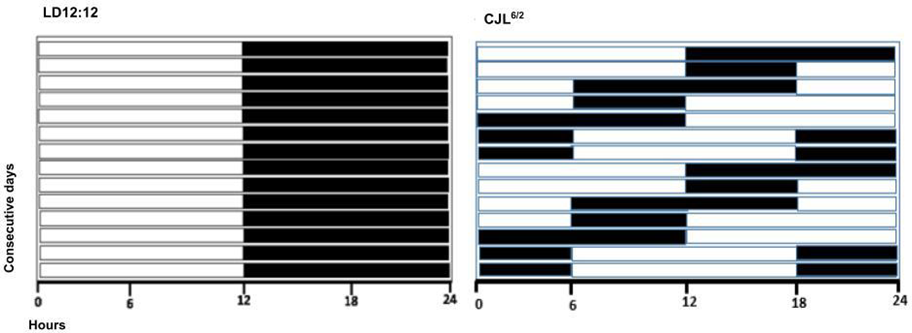Advanced Search
Advanced Search
(Note: Currently this function is only available for searching protocols.)
- Anywhere
- Title
- Abstract
- Author
Experimental lighting schedules
Published: Jan 11, 2023 Views: 533
Chronic jet-lag protocol
Adult (2-month old) C57bl/6 J WT male mice (Mus musculus) were housed individually with food and water ad libitum.
The chronic jet-lag (CJL) schedule was previously designed by our group (Casiraghi 2012) and consisted in a 6h advance of the LD cycle every 2 days (CJL6/2); which was accomplished through a 6h shortening of every second dark phase (Fig. 1).
Effective circadian desynchronization was evaluated by observation of a particular activity pattern which included two components of activity rhythms with periods of about 21h and 24.7h. General activity was detected by infrared sensors connected to a computer interface that records activity counts every five minutes for posterior time-series analysis (Archron, Buenos Aires, Argentina).
Zeitgeber time (ZT) was used as a temporal reference: ZT0 is the moment of lights on, and ZT12 the moment of lights off. For the CJL schedule, samples were taken during the 12-h night and on the following day

Figure 1. Schematic light schedules of LD12:12 and CJL6/2cycles. White bars represent the light time and the black bars represent the night time. Mice were subject to these light schedules for 3 weeks before tumor cells inoculation.
References
L. P. Casiraghi, G. A. Oda, J. J. Chiesa, W. O. Friesen, D. A. Golombek, Forced desynchronization of activity rhythms in a model of chronic jet lag in mice. Journal of biological rhythms 27, 59-69 (2012).
Do you have any questions about this protocol?
Post your question to gather feedback from the community. We will also invite the authors of this article to respond.
Tips for asking effective questions
+ Description
Write a detailed description. Include all information that will help others answer your question including experimental processes, conditions, and relevant images.


